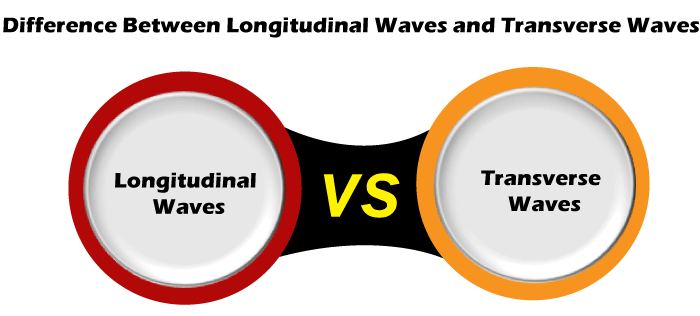Difference between Longitudinal and Transverse Waves
We have studied many kinds of waves in our physics lectures, like sound waves, frequency waves, etc. But out of these waves, longitudinal and transverse waves are important topics that we will be discussing today. So, without further ado, let us begin.
Longitudinal Waves are defined as waves that are capable of displacing the medium in a particular direction. They move either in the direction of the waves or opposite them. Longitudinal mechanical waves are known as compressional waves. This is because these mechanical waves produce a lot of compression and pressure while traveling through medium. These waves are also called as pressure waves as there is an increase and decrease in pressure while traveling.

Sound Waves like vibrations, P-Waves created through earthquakes, etc., are some kinds of longitudinal waves. In longitudinal waves, the medium and the waves are parallel to each other. Longitudinal Waves are also called L-Waves. But here, it is important to note that this abbreviation has a completely different meaning in electrocardiography and seismology. In seismology, the L-Wave stands for the love waves. This is the reason why some people chose to call it ‘l-wave.’ However, there is no particular mention of the abbreviations; still, they are used by people for their convenience. This kind of terminology is also seen in science-fiction books.
As said earlier, that sound waves are a part of longitudinal waves. So, to calculate the wavelength and frequency of these waves, the following formula is used:
In the formula mentioned above, Y is depicted as the displacement; X is the distance from where the wave has traveled; T stands for time; y0 is the periodic variable; C stands for speed, and W for the frequency of the wave.
It is important to note that the speed of the sound wave depends upon the temperature, pressure, type, and composition of the medium. Medium is the most important aspect out of this as it shows the wave that has traveled.
Pressure waves are another kind of longitudinal wave. Pressure waves are seen in cases where the velocity is completely dependent upon the density of the material. The formula mentioned above is used in calculating the pressure waves as well.
Longitudinal Waves also include plasma waves. Plasma waves are defined as waves that are interconnected with particles and move in a particular direction. There are three main kinds of longitudinal waves, i.e., seismic waves (earthquake, volcano), sound waves, and ultrasound waves. These waves move parallel to the direction from where the waves travel. Longitudinal waves are commonly seen in the pushing or pulling of strings. When we push or pull strings, the waves or the force applied are parallel to one another. Thus, longitudinal waves move in a parallel direction.
With the concept of longitudinal waves, there comes one more kind of wave, i.e., the transverse waves. A transverse wave is defined as the wave that moves in the perpendicular direction. One of the most important examples of transverse waves includes the waves created by the drum’s beating. The membrane of the drum moves perpendicular to the surface.
Another example of a transverse wave is light. Light creates magnetic and electric fields that depict the medium and way of the direction of light. Transverse waves are mostly present in solids that have profound elasticity. In some cases, when there is a deformation in the material, the wave is called a shear wave. In seismic terms, these kinds of waves are also called S-Waves (secondary waves). The oscillations of the transverse waves occur in the same direction of the waves.
There is a mathematical formulation, too, for these transverse waves. In mathematics, the easiest type of transverse wave is called ‘linearly polarized sinusoidal.’ This is also called a plane wave because of its unchanging direction of traveling. Some of the examples of transverse waves include:
- Ripples on the water surface
- Guitar strings
- Electromagnetic waves like light waves, radio waves, or microwaves
- S-Waves or Secondary Waves
It is interesting to note that transverse waves travel in the medium through both high and low densities. This process is called rarefaction and compression. According to rarefactions and compression, it is seen that the transverse waves only travel through solids. Thus, transverse waves are perpendicular to one another and can only travel through solid objects.
Having discussed both the terms separately, let us see the difference between the longitudinal and transverse waves.
| S.NO. | LONGITUDINAL WAVES | TRANSVERSE WAVES |
|---|---|---|
| 1. | In longitudinal waves, the waves travel either in the same direction or opposite each other. | On the other hand, in transverse waves, the waves travel in a perpendicular direction. |
| 2. | Longitudinal waves are present on one-dimensional objects. | Transverse waves are present in two-dimensional objects. |
| 3. | The longitudinal wave is not polarized. | The transverse wave is polarized and aligned. |
| 4. | Longitudinal waves can travel through gas, liquid, and solid objects. | Transverse waves can only travel through solids. |
| 5. | The longitudinal waves are created through the process of rarefactions and compression. | On the other hand, the transverse waves are created through troughs and crests. |
| 6. | The longitudinal waves move in a parallel direction. | The transverse waves travel in the perpendicular direction. |
These are some key points regarding longitudinal and transverse waves. Both these waves have distinctive features and are one of the most important topics in physics. Longitudinal waves and transverse waves have the main difference in direction. Longitudinal waves are of three types, whereas transverse waves are of two types. Thus, both longitudinal and transverse waves are important in their sense.
